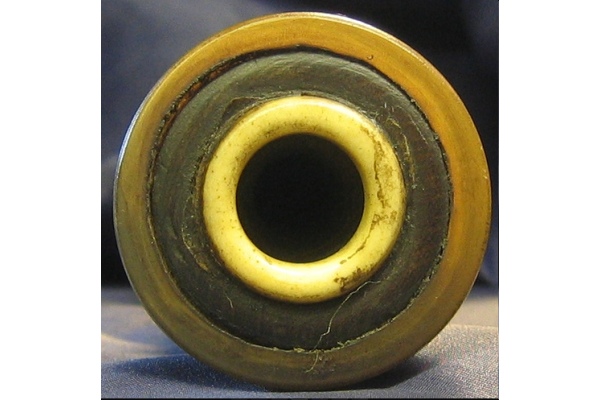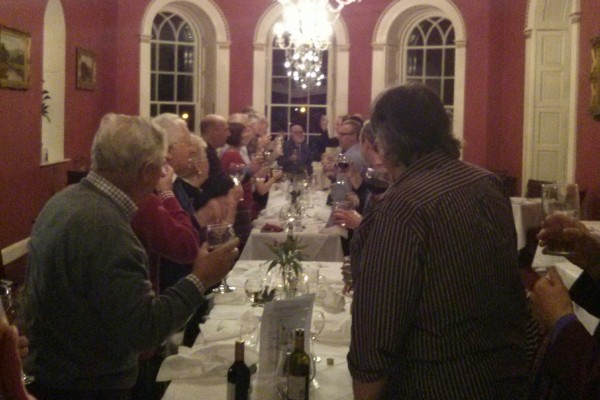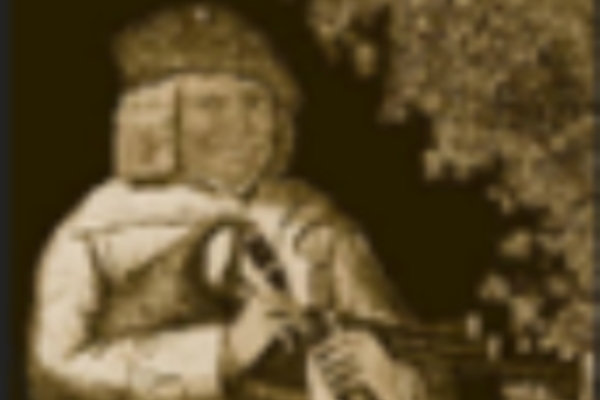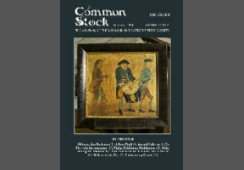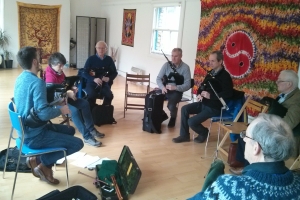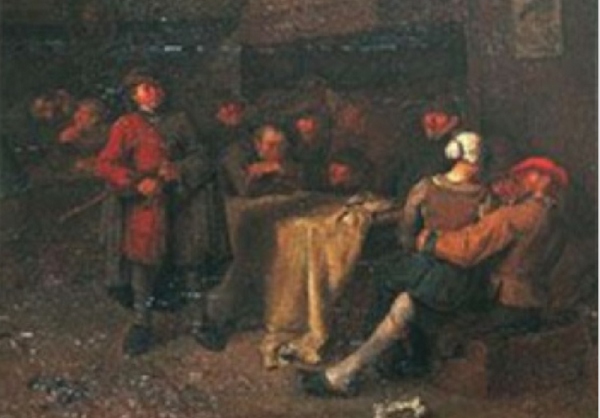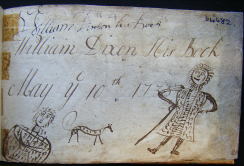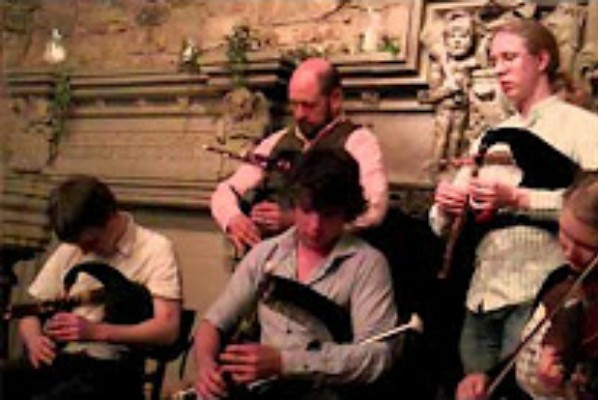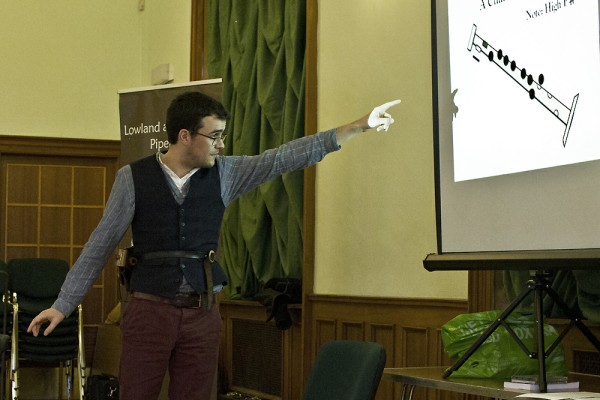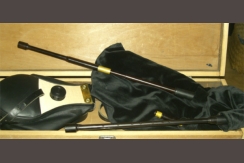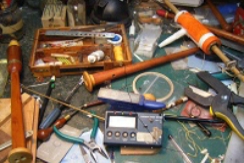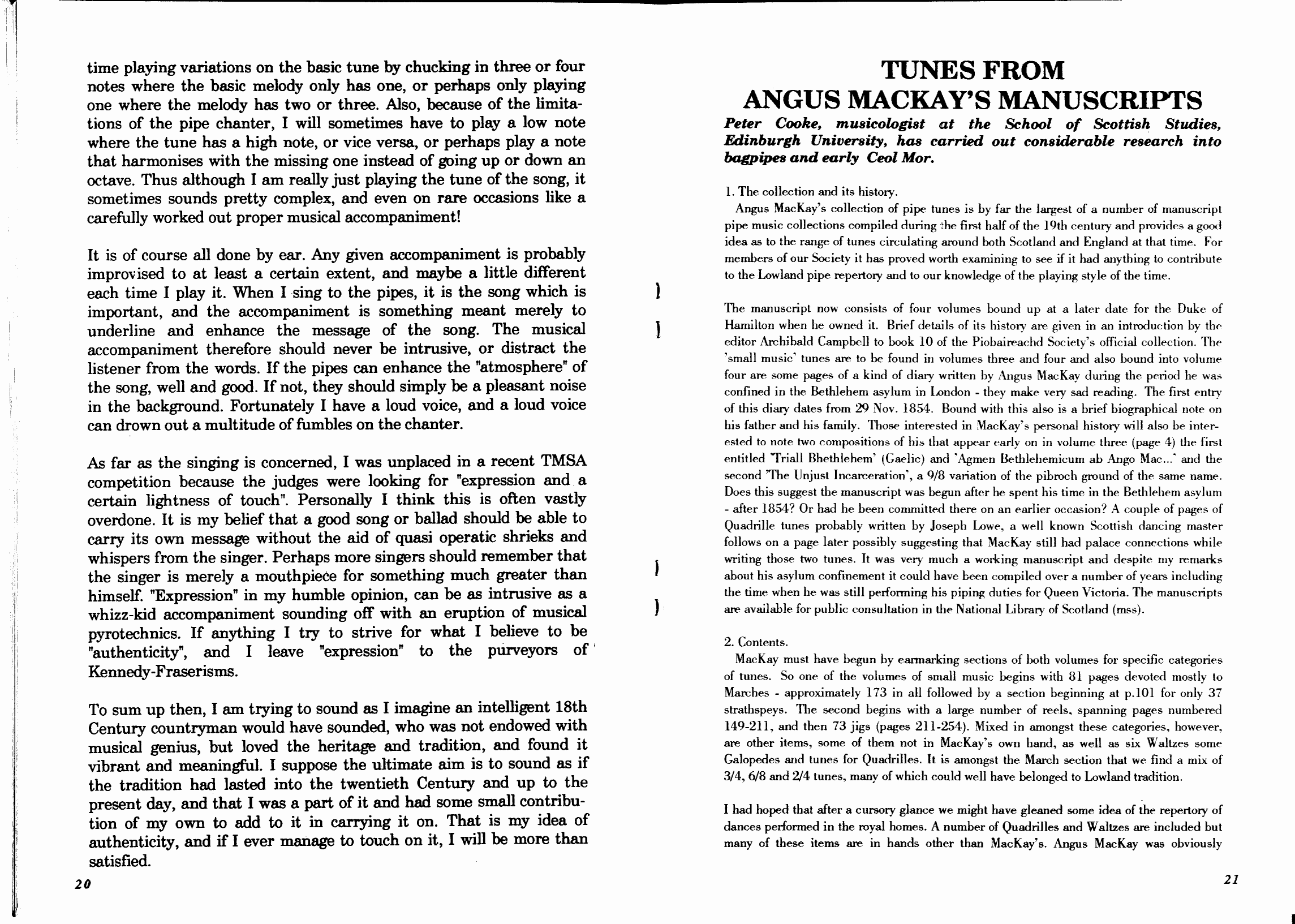

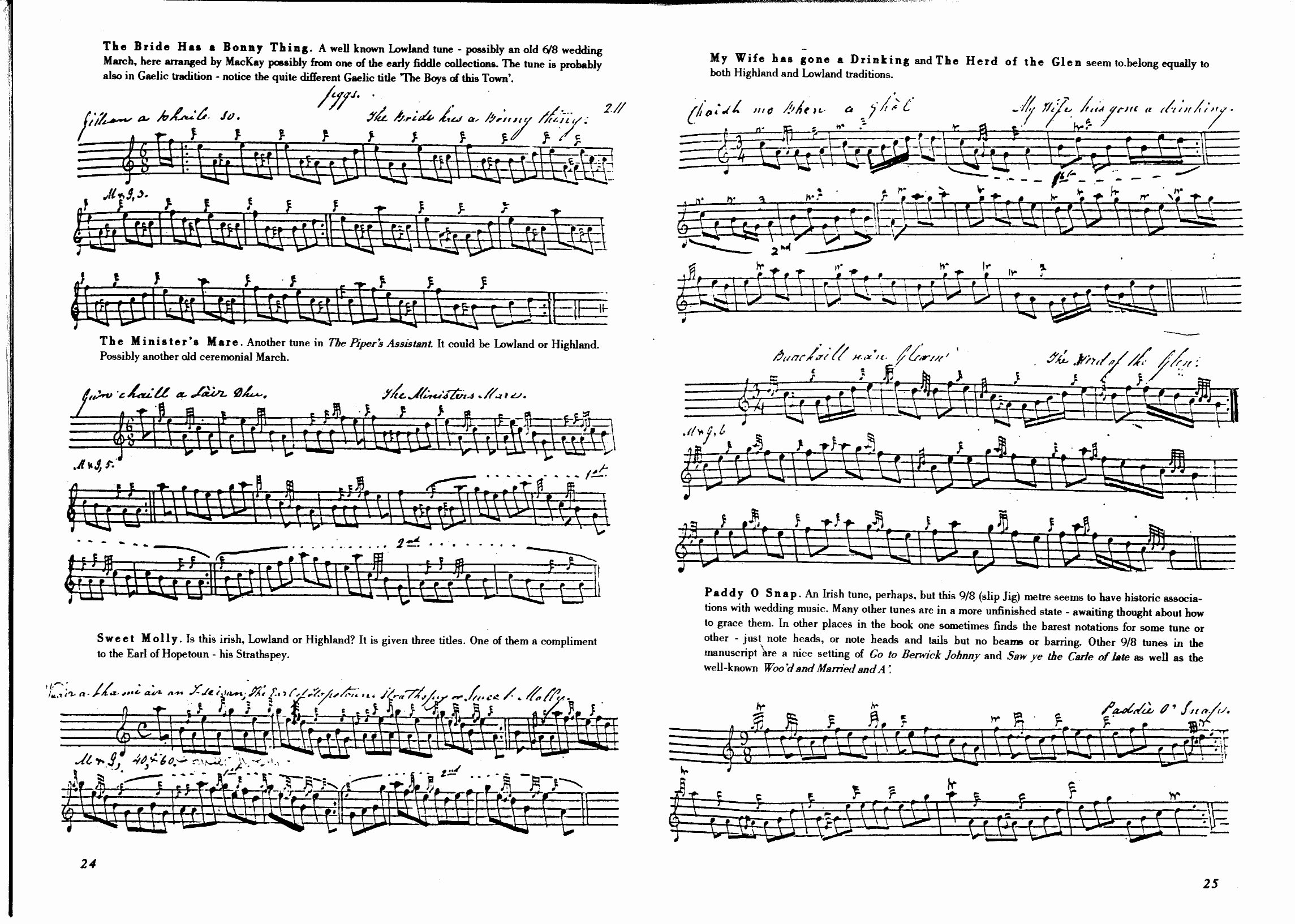
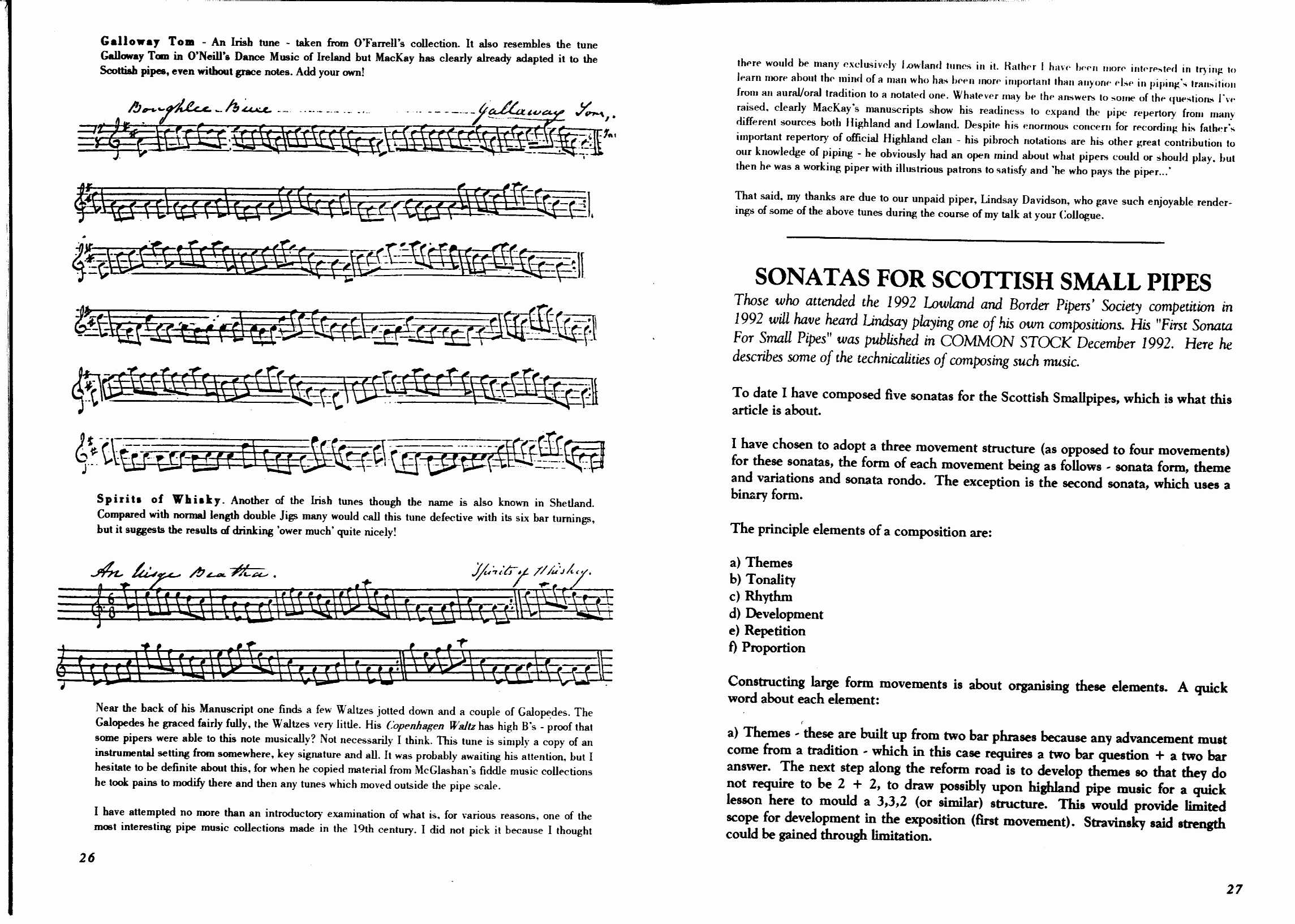
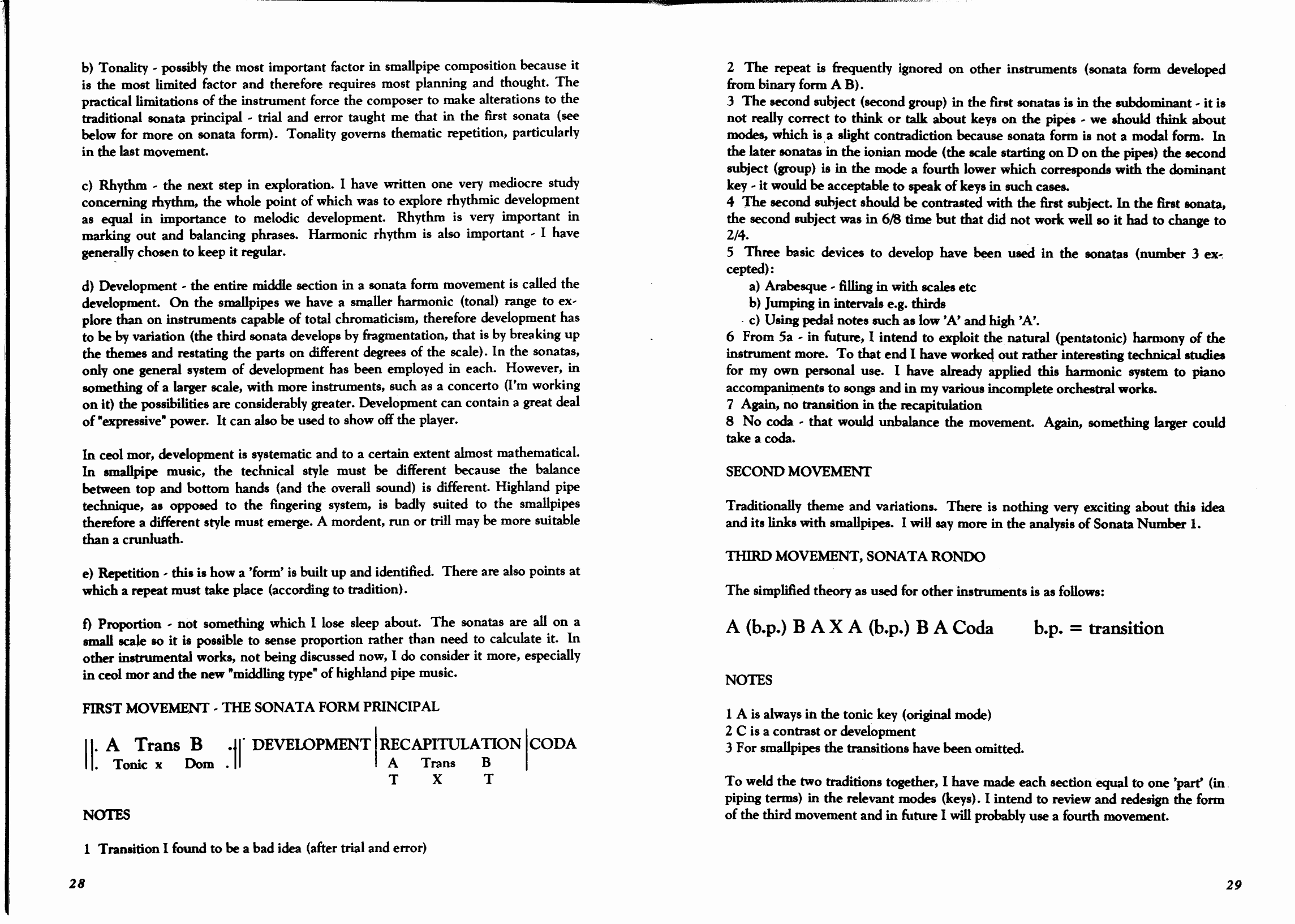
Peter Cooke, musicologist at the School of Scottish Studies, Edinburgh University, has carried out considerable research into bagpipes and early Ceol Mor.
1. The collection and its history.
Angus MacKay’s collection of pipe tunes is by far the largest of a number of manuscript pipe music collections compiled during the first half of the 19th century and provides a good idea as to the range of tunes circulating around both Scotland and England at that time. For members of our Society it has proved worth examining to see if it had anything to contribute to the Lowland pipe repertory and to our knowledge of the playing style of the time.
The manuscript now consists of four volumes bound up at a later date for the Duke of Hamilton when he owned it. Brief details of its history are given in an introduction by the editor Archibald Campbell to book 10 of the Piobaireachd Society's official collection. The ‘small music’ tunes are to be found in volumes three and four and also bound into volume four are some pages of a kind of diary written by Angus MacKay during the period he was confined in the Bethlehem asylum in London - they make very sad reading. The first entry of this diary dates from 29 Nov. 1854. Bound with this also is a brief biographical note on his father and his family. Those interested in MacKay’s personal history will also be inter- ested to note two compositions of his that appear early on in volume three. (page 4) the first entitled “Triall Bhethlehem’ (Gaelic) and “Agmen Bethlehemicum ab Ango Mac...” and the second "The Unjust Incarceration’, a 9/8 variation of the pibroch ground of the same name. Does this suggest the manuscript was begun after he spent his time in the Bethlehem asylum
- after 1854? Or had he been committed there on an earlier occasion? A couple of pages of Quadrille tunes probably written by Joseph Lowe, a well known Scottish dancing master follows on a page later possibly suggesting that MacKay still had palace connections while writing those two tunes. It was very much a working manuscript and despite my remarks about his asylum confinement it could have been compiled over a number of years including the time when he was still performing his piping duties for Queen Victoria. The manuscripts are available for public consultation in the National Library of Scotland (mss).
2. Contents.
MacKay must have begun by earmarking sections of both volumes for specific categories of tunes. So one of the volumes of small music begins with 81 pages devoted mostly to Marches - approximately 173 in all followed by a section beginning at p.101 for only 37 strathspeys. The second begins with a large number of reels, spanning pages numbered 149211, and then 73 jigs (pages 211-254). Mixed in amongst these categories, however, are other items, some of them not in MacKay’s own hand, as well as six Waltzes some Galopedes and tunes for Quadrilles. It is amongst the March section that we find a mix of 3/4, 6/8 and 2/4 tunes, many of which could well have belonged to Lowland tradition.
I had hoped that after a cursory glance we might have gleaned some idea of the repertory of dances performed in the royal homes. A number of Quadrilles and Waltzes are included but many of these items are in hands other than MacKay’s. Angus MacKay was obviously friendly with Joseph Lowe who as the best knownScottish dancing master of the time hac. I believe, conducted dance events at Balmoral and possibly Windsor also. What appears to be Lowe’s hand can be found in both volumes. His first contribution is a set of Quadrille pieces (in 6/8 and 2/4 time) placed early in the section containing the Marches, which seem to have inspired MacKay also to note down a set of tunes entitled ‘Irish Quadrilles’ im- mediately afterwards. Lowe’s settings are unfinished and the first tune begins outside the range and probably the key of the bagpipe. MacKay’s own Quadnrille selection seems to have been hurriedly written out and the tunes ungraced. These tunes are a mix of wellknown Highland and Lowland 6/8 Jigs and 2/4 pieces. Normality returns on page 21 when MacKay returns to his careful compilation of tunes entitled Marches. In volume two Lowe pens a page of tunes - the Prince of Wales Strathspey, Prince Albert’s Reel and a Strathspey and Reel set entitled The Queen’s Piper. The first two are clearly fiddle tunes and go outside the bagpipe range, his tunes to MacKay, however, do at least pay him the compliment of lying within the pipe scale and sounding very Highland even though they are not pipe settings. At the back of the second volume are two other sets of Quadrilles - the Royal Scottish and the Royal Irish - but not set for the pipes and in some unknown hand - though MacKay has added in the titles.
3. Editorial Methods,
When I say these are working manuscripts I mean that MacKay was obviously compiling as many tunes as he could, noting them down to varying degrees of detail - some are fully graced, others sketchily and others not at all. The selection of tunes for the Irish Quadrilles are marked "change the key’ so clearly MacKay was using this manuscript as a storehouse of finished and unfinished tunes.
A large proportion of the tunes are, however, neatly copied from printed collections and he usually indicates his sources and their page numbers. Many tunes are marked ’M & G’ with a page reference - these are tunes to be found in that important early printed collection The Piper's Assistant - edited by Angus MacKay and published by Glen for the first time in 1843 (see Roderick Cannon’s bibliographic entry No.310). This book contains tunes which publishers and compilers have drawn on many times since. But MacKay also copied tunes from the Donald MacDonald and William Gunn pipe music books and from Alexander McGlashan’s Collection of Reels (a fiddle music collection that appeared in 1781). Lastly I should also mention Wilson (whose Companion to the Ballroom (1816) provided MacKay with other tunes) and O’Farrell’s Irish collection. At least two other pipers are cited - a McDougall and a Duncan McKerrcher - possibly a piper who had made a manuscript collection which was never published. There are many other tunes, some of them untitled, for which no source is given.
What is not clear to me is if the tunes labelled "M&G’ (usually followed by the appropriate page reference) were published from this manuscript (and that fact noted later) or if this is a second manuscript into which he has copied tunes from this earlier published collection. Perhaps a closer examination will answer this question.
As you would expect, MacKay being a Highlander - like his illustrious father he was a na- tive of the island of Raasay - many of the tunes are clearly of Gaelic Highland origin. But the problem of sorting out Highland from Lowland repertory is compounded by his providing each tune with both Gaelic and English titles. Some could be his own Gaelic translations for tunes of non-Gaelic origin, many others the converse. No doubt many tunes were well known in both traditions. I’ve chosen a few today to illustrate some of the problems and to provide some attractive settings for you to try out on your pipes.
Maggie Lauder. The air of a well-known Lowland Scots song. MacKay possibly took this from some fiddle collection - otherwise he would not have written in the key signature of two sharps. It is lightly graced to help preserve the flowing nature of the tune - or is this one he took from a possible McKerrcher collection I mentioned earlier? I have not had time to check on the existence of a fiddle book which could have been the source - note the ‘KER...’ During the binding process the manuscript pages were trimmed down and un- fortunately marginal notes on this and many other tunes were trimmed away too.
Logan Water. Where is Logan Water - is it one of the Ayrshire Logans? In the Buchan dis- trict the tune is associated with the ballad called "The Cruel Mother’. Is this a tune MacKay arranged? It passed on down as a March in piping books, notably later editions of the Glen collections. Notice there is no real second turning but a modification of the first - a clue that it is probably an old single strain ballad tune that could have belonged to either Highland or Lowland tradition. It was certainly well known in the Lowland ballad tradition as a tune for The Cruel Mother and a fine recording of the ballad sung to this tune can be heard on Alison McMorland’s Belt Wi’ Colours Three (played over at the Collogue -tangent records TGS 125). At the Collogue Matt Seattle commented that Logan Water can be found in one of the 18th century fiddle music collections. I have since discovered a setting of it, probably made by the editor Robert McIntosh, in Charles McLean’s A Collection of Favourite Scots Tunes (1772). See David Johnston’s detailed discussion of this collection in his Scottish Fiddle Music of the 18th Century, Edinburgh, 1984, p.9-13.
The Bride Has a Bonny Thing. A well known Lowland tune - possibly an old 6/8 wedding March, here arranged by MacKay possibly from one of the early fiddle collections. The tune is probably also in Gaelic tradition - notice the quite different Gaelic title "The Boys of this Town’.
The Minister’s Mare. Another tune in The Piper’s Assistant, It could be Lowland or Highland. Possibly another old ceremonial March.
Sweet Molly. Is this Irish, Lowland or Highland? It is given three titles. One of them a compliment to the Earl of Hopetoun - his Strathspey.
My Wife has gone a Drinking and The Herd of the Glen seem to belong equally to both Highland and Lowland traditions.
Paddy O Snap. An Irish tune, perhaps, but this 9/8 (slip Jig) metre seems to have historic associations with wedding music. Many other tunes are in a more unfinished state - awaiting thought about how to grace them. In other places in the book one sometimes finds the barest notations for some tune or other - just note heads, or note heads and tails but no beams or barring. Other 9/8 tunes in the manuscript are a nice setting of Go to Berwick Johnny and Saw ye the Carle of late as well as the well-known Woo'd and Married and A’.
Spirits of Whisky. Another of the Irish tunes though the name is also known in Shetland. Compared with normal length double Jigs many would call this tune defective with its six bar turnings, but it suggests the results of drinking ‘ower much’ quite nicely!
Spirits of Whisky. Another of the Irish tunes though the name is also known in Shetland. Compared with normal length double Jigs many would call this tune defective with its six bar turnings, but it suggests the results of drinking ‘ower much’ quite nicely!
Galloway Tom - An Irish tune - taken from O’Farrell’s collection. It also resembles the tune Galloway Tom in O’Neill’s Dance Music of Ireland but MacKay has clearly already adapted it to the Scottish pipes, even without grace notes. Add your own!
Near the back of his Manuscript one finds a few Waltzes jotted down and a couple of Galopedes. The Galopedes he graced fairly fully, the Waltzes very little. His Copenhagen Waltz has high B's - proof that some pipers were able to this note musically? Not necessarily I think. This tune is simply a copy of an instrumental setting from somewhere, key signature and all. It was probably awaiting his attention, but I hesitate to be definite about this, for when he copied material from McGlashan’s fiddle music collections he took pains to modify there and then any tunes which moved outside the pipe scale.
I have attempted no more than an introductory examination of what is. for various reasons. one of the most interesting pipe music collections made in the 19th century. I did not pick it because I thought there would be many exclusively Lowland tunes in it. Rather I have been more interested in trying to learn more about the mind of a man who has been more important than anyone else in piping’s transition from an aural/oral tradition to a notated one, Whatever may be the answers to some of the questions I’ve raised, clearly MacKay’s manuscripts show his readiness to expand the pipe repertory from many different sources both Highland and Lowland. Despite his enormous concern for recording his father's important repertory of official Highland clan - his pibroch notations are his other great contribution to our knowledge of piping - he obviously had an open mind about what pipers could or should play, but then he was a working piper with illustrious patrons to satisfy and "he who pays the piper...”
That said, my thanks are due to our unpaid piper, Lindsay Davidson, who gave such enjoyable renderings of some of the above tunes during the course of my talk at your Collogue.
